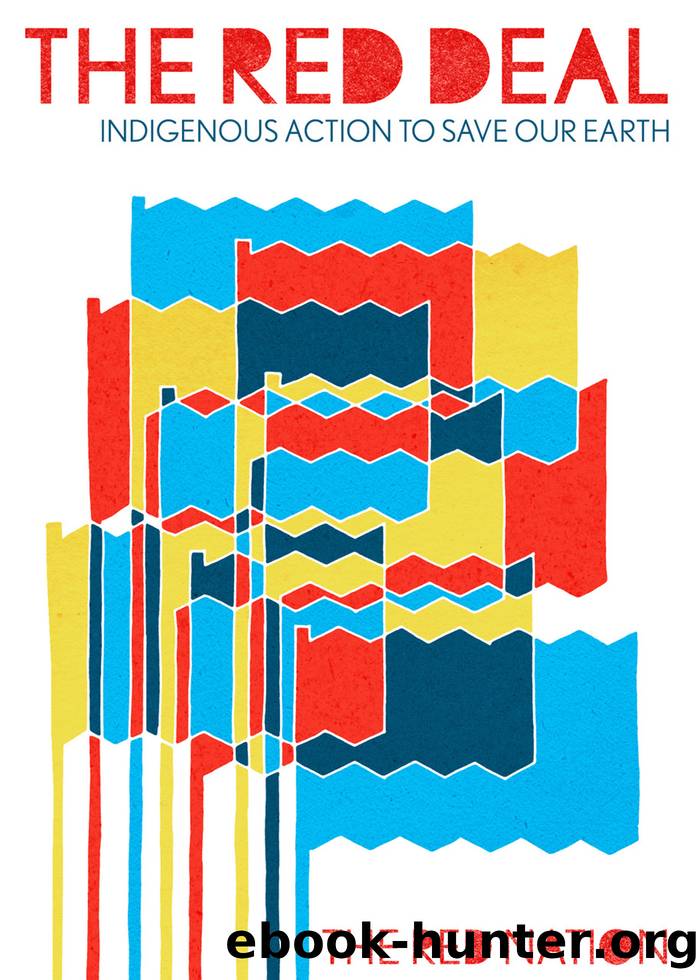The Red Deal by The Red Nation;

Author:The Red Nation;
Language: eng
Format: epub
Publisher: Lightning Source Inc. (Tier 2)
Published: 2021-10-15T00:00:00+00:00
Area 2: Free and Sustainable Housing
Close your eyes, take a breath, and allow yourself to imagine a world where all people enjoy safe, comfortable housing. Imagine a world where no one is poor or hungry, where all families are allowed to stay together and nurture their homes. Imagine a world where having a home does not depend on money or status, but simply on the fact that you are a human being. Imagine a world where everyone has a true home; not just a shelter, but a real home filled with love, laughter, food, rest, and joy. Now, open your eyes and look around at what currently counts as a âhomeâ: unsheltered relatives sleeping on sidewalks and under tarps, thousands of families living in cars, urban housing filled with cockroaches and cancer-inducing lead, overcrowded reservation houses with no running water or heat, and rundown apartment complexes that overcharge for rent and exploit tenants.
There is no safety or dignity under capitalism. Not only do most working-class people have no true home, but many do not even have adequate shelter. Millions are one paycheckâand in some cases, less than a weekâaway from being unsheltered. According to the Department of Housing and Urban Development (HUD), 42,000 to 85,000 Natives would be unsheltered if relatives were unable or unwilling to squeeze multiple families into already overcrowded homes.2 Furthermore, HUD estimates an approximate total of 68,000 new housing units are needed in tribal areas to combat this invisible housing crisis, a total that matches the more visible ten-year housing plan already in the works for New York Cityâs crisis. While poor, working-class, and unsheltered people are suffering through this housing crisis, a surplus of empty private properties exist across the United States and placement for unsheltered people and families could easily be madeâif this was a priority. Housing is inaccessible when profit cannot be made of it. Itâs clear that we cannot depend on a capitalist system that values profit over people to fix this ongoing crisis.
Much of our attention as leftists and progressives is paid to unsheltered folks, those who live on the streets and are considered âhomeless.â But is a house without heat, water, or electricity really a âhome?â Is a shelter without a functional kitchen or a safe place to sleep really a home? A 2016 article in The Atlantic noted that of the 135 million homes in the United States, thirty million are hazardous.3 This means thirty million families are regularly and unfairly exposed to health risks like asthma and pneumonia that reduce life expectancy and affect everything from mental health to education. And, although heating and electricity for private residences is the greatest contributor to carbon emissions, the mansions and McMansions belonging to the upper classes are clearly responsible for a large chunk of these emissions. After all, how can reservation or urban dwellings without heat or electricity possibly contribute to carbon emissions?
Our homes are where we live our lives, and perform basic functions like cooking, eating, sleeping, bathing, and making kin.
Download
This site does not store any files on its server. We only index and link to content provided by other sites. Please contact the content providers to delete copyright contents if any and email us, we'll remove relevant links or contents immediately.
Blood and Oil by Bradley Hope(1250)
Daniel Holmes: A Memoir From Malta's Prison: From a cage, on a rock, in a puddle... by Daniel Holmes(1118)
Ambition and Desire: The Dangerous Life of Josephine Bonaparte by Kate Williams(1088)
Wandering in Strange Lands by Morgan Jerkins(1019)
It Was All a Lie by Stuart Stevens;(942)
What Really Happened: The Death of Hitler by Robert J. Hutchinson(871)
London in the Twentieth Century by Jerry White(848)
Time of the Magicians by Wolfram Eilenberger(844)
The First Conspiracy by Brad Meltzer & Josh Mensch(813)
Twilight of the Gods by Ian W. Toll(813)
The Japanese by Christopher Harding(803)
A Woman by Sibilla Aleramo(797)
Lenin: A Biography by Robert Service(780)
The Devil You Know by Charles M. Blow(779)
Reading for Life by Philip Davis(775)
Cleopatra by Alberto Angela(769)
Twelve Caesars by Mary Beard(769)
1965--The Most Revolutionary Year in Music by Andrew Grant Jackson(715)
The Life of William Faulkner by Carl Rollyson(714)
